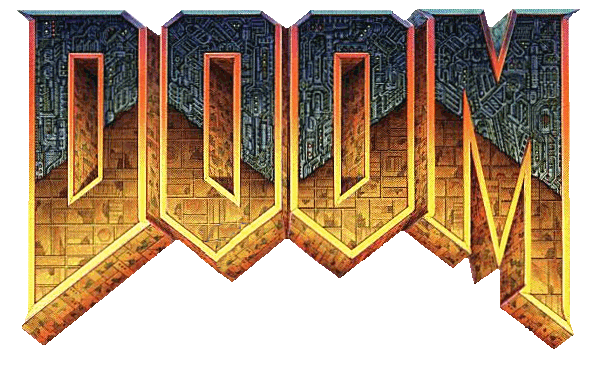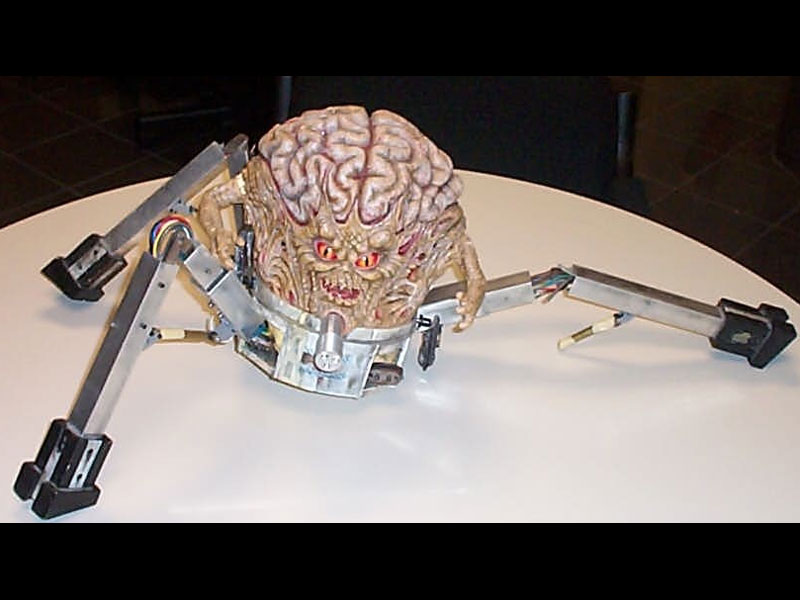25 years DOOM

Before there were platformers and unpretentious 3D frame games with cartoon graphics. After that, more and more realistic FPS appeared.
Until was its control for each game. After the player began to control the look and direction with the mouse, and movement using the keyboard.
Before there were single-player games, sometimes - splitting the screen, or zero-modem connection of a pair of computers. After that, network battles appeared, where the best reward for the winner was scraps of flesh scattered in all directions. Appeared eSports.
Till were quiet games with pleasant music. After the game appeared, the full roar of monsters and heavy, aggressive music.
Before there was a DOOM, and after ...
On December 10, 1993, Jay Wilbur, the then CEO of id Software (read, “iD Software”), only after calling the University of Wisconsin network administrator was able to connect to the university's ftp server in order to download the distribution kit of the game he had just created DOOM. Too many users were expecting this game, and the administrator had to throw out users, so that id could download the distribution. Even increasing the connection limit did not help. After the download of the distribution was completed, the university network fell, unable to withstand the influx of users.
Starting the development of DOOM, id Software was already a famous studio among players. Their hits Wolfeinstein 3D and Commander Keen enjoyed impressive success, and brought a lot of decent money, despite the fact that they could not be seen on store shelves. As, in fact, it was impossible to find and advertising firms. But you could absolutely free download the games id Software with BBS or copy from a friend (the game installer wrote, PLEASE, DISTRIBUTE) and play in the first few levels. And for the rest, it was necessary to send the distributor (at that time, the company Apogee) a check with a certain amount and get in return a floppy disk with the full version of the game. Thanks to this scheme (and, of course, the quality of the games themselves), id Software has become a very popular player company, and by the time it was released, DOOM were awaiting crowds of dedicated fans.

Surprisingly, instead of a bloody and dismal DOOM, a completely different game could see the light: after the Wolfeinstein 3D series, Tom Hall, at that time the chief designer of id Software, suggested resuming the Commander Keen series, but continuing on to 3D. At first, John Carmack, the chief programmer at the company and the developer of all of its engines, supported Tom's idea, but over time he had a better idea: playing with monsters from hell. Being a huge fan (and master of the game) of Dungeons and Dragons, Carmack quickly switched to a new idea, which all the other members of the team liked much more than Commander Keen Tom. The name, according to the official version, came from the Martin Scorsese film “The Color of Money” with Tom Cruise in the title role, where the hero answered this question to the question what was in his suitcase. There was a cue, with the help of which the hero of Cruise earned huge money by playing pool. The development of DOOM is also related to another “winged” expression of Carmack, that “the plot in the game is akin to the plot in a porn film: of course, it’s supposed there, but not dominant”. This was John’s response to Tom Hall’s desire to have some interesting and complex plot in DOOM.

Starting the development of DOOM, the company moved to a gloomy building, a Town East Tower in the suburb of Mezquita, calling its new office “appartments 666”. The demonic symbolism was everywhere in DOOM: for example, the main version of the program was number 1.666. This style was very much in the soul of Adrian Carmack (just John's namesake, not a relative), designer of id Software. As a teenager, Adrian worked at the hospital reception. There through his hands took pictures of patients suffering from various diseases. A. Carmack and without it the dark art, but it was this experience that helped him create art for DOOM. Monsters for DOOM were first created from clay, then videotaped from different angles, digitized the obtained frames and adapted to the game palette. They even used their own parts for the game: hand,

Graphically, DOOM worked in VGA mode with a linear framebuffer (in 13h mode ) (actually, not really. It was Y mode , thanks mistergrim). This mode only needed 64 KB of video memory and, although DOOM worked in a 32-bit protected mode of the processor and did not have to work with a segmented 16-bit real mode memory, such a compact framebuffer allowed working with double buffering, which made the screen animation smoother . While the video adapter was displaying one buffer, the drawing went to another. Then, the buffers were switched, and the frame just drawn started to be displayed on the monitor, and the engine started drawing the next frame into the first buffer. In addition, in this mode, the developer had access to a palette of 8 bits (256 colors), selected from a full color space of 18 bits (262 thousand colors, or 6 bits for each of the main color channels). DOOM used only a part of this palette, but in several variations of brightness. This is how the lighting in the game was imitated: the farther the texture was from the user, the darker the palette for it was chosen, so that all the long corridors were always drowning in demonic darkness. Due to the fixed size, changing the palette for texture required a trivial calculation, and it happened very quickly. “Dynamic” lighting also worked when the game was turned off or the light was flickering.
Despite the first-person perspective, DOOM, like its predecessor Wolfeinstein 3D, was a two-dimensional game. Yes, unlike Wolfeinstein 3D, DOOM had stairs and floors of different parts of the level were located at different heights, as well as the ceiling, but creating one room above another in DOOM was impossible - the levels were still two-dimensional labyrinths, only became "hilly" . Creation levels were divided into “sectors”, and each sector could have its own individual floor height. To increase performance, during creation levels were preprocessing. Using binary partitioning of spacethe level was divided into small sections of convex subsectors within which there were no walls. Then a visibility index was created for each such sub-sector: which neighboring sub-sectors were potentially visible from it. And only the potentially visible sub-sectors were processed further by the engine, the rest were discarded, which saved resources great.
The rendering system itself, like the tools for creating game content, was written by John Carmack on the Next Station computer, which he acquired after the resounding success of Wolfeinstein 3D. Objective-C language was used for development.
One can argue whether DOOM was the best game of its time, but it was absolutely the best. The fan community was huge, the creators of the game were greeted everywhere like rock stars, they were recognized on the street, the fans made raids on the id Software office. There was a reason for this: DOOM was a game with a dynamic and depth of immersion unprecedented until this time, the monsters in the game were diverse, and the levels were really interesting and unusual. One of the main "chips" of the DOOM engine was the support of walls intersecting at an arbitrary angle. This was impossible to achieve on the engine of the past generation, it was a breakthrough, and the design of the game exhibited this chip for show: the game was full of winding, serpentine corridors, semicircular walls and oval rooms, which is rare in real life. This only strengthened the "otherworldly" effect of the game.
And the game was full of secrets. At each level, many secret rooms were scattered, but there were even secret levels at which you could even play Pac Man on the DOOM engine (No, Pac Man was in Wolfeinstein 3D, and in DOOM there were secret levels from Wolfeinstein 3D and Commander Keen - thanks mao_zvezdun Cerberuser juray ). By the way, the last secret of the game was revealed just less than a year ago!
All DOOM game resources were packed into a single file with the WAD extension (where's all the data), but DOOM was originally created with an eye for users to want to modify the game. John Carmack was originally a supporter of opening the source code of his games, but the code was not laid out in public access immediately, but only after some time. However, id Software has laid out enough information about the internal structure of the engine and content development tools for users to quickly start making their own modifications to the game. The DOOM engine (later named id Tech 1) was the first id Software engine that the company licensed to third-party firms, and although there were not too many games using this engine, it laid the foundation for a new business for the company: technology licensing.
DOOM was a very dynamic game, the protagonist could reach a speed equivalent to 56 km / h . In this game, although it was painted mainly in dark colors, had a lot of bright and blood-red, acid-green or electrically-blue spots. In addition, the game provided an unprecedented degree of immersion in the virtual world. It is not surprising that some players are well rocked from a long game. One of the first victims of the dynamics of the game was Dave Taylor, an employee at id Software, who was joked about in the office about this.
The network game was planned for the thought from the very beginning. Just starting the development of the future engine, John Carmack told John Romero about his idea of a network game. A little later, the word "deathmatch" appeared. According to the stories, Romero invented it. This word for many years to come will become the hallmark of the games of the company, but it appeared precisely during the development of DOOM. Began to appear clubs where players could fight online. So began to emerge eSports.
Also, it is DOOM, or rather the DWANGO network, created in 1994 by Bob Huntley and Key Kimbrell, opened up a completely new era of network games. The Internet in that era was still in a rather rudimentary state, and the DWANGO servers used a modem pool, which users dialed to play online. Over time, the small company grew into a rather large money machine: the network creators began selling franchises, and the DWANGO client was included in the distribution of later versions of DOOM and some games on the DOOM engine, such as Heretic or Hexen. With the development of the Internet, more and more games began to offer online gameplay, and now this does not surprise anyone. But it also began with DOOM.
It was decided to sell DOOM 2 on store shelves, not on the Shareware model, so there is no free (shareware) version of DOOM 2. Interestingly, when Quake was sold, id Software returned to the shareware model, slightly modifying it (the whole game was hosted on a shareware disk, but some were encrypted. The encryption was quickly hacked by pirates). It was during the work on DOOM 2 that the friction between John Carmack and John Romero began, which led the latter to leave the company soon after Quake's exit. As a result, no one won: id Software games began to gradually give up their positions, first turning more into the Carmack technology exhibition without really interesting game dynamics (DOOM 3), then competitors became much more involved in engine building than id Software. As a result Now we see the games based on the Unreal Engine on the market, for a long time the “exhibition” of modern technologies was the Cry Engine, and the id Software engines have lost most of the market. Romero also didn’t really succeed in the field of game development, his company Ion Storm went bankrupt, and his personal ambitious project Daikatana became one of the loudest failures in the gaming industry.
DOOM 3 marked the beginning of the end id Software. Yes, even at the time of the first Quake, the Unreal game showed that you can compete with Carmack, and quite successfully. But it was not even about technology. At the time of 1st DOOM, 3D shooters were a fresh genre, there was little variety of games, but over time everything changed. Half Life introduced the plot into the genre, new game mechanics appeared, but id Software continued to do the same thing: games with a plot, like in a porn movie. Players were no longer interested in such games, and DOOM 3 was overshadowed by such masterpieces of the genre as Half Life 2, Chronicles of Riddick, Painkiller, Far Cry, released in the same year. In terms of technology, DOOM 3 still looked great, but the game mechanics were mediocre for that time, especially against the background of such powerful competitors. And the last DOOM was released without the participation of Carmack,
The creators of DOOM, of course, earned a lot of money, but none of them became fabulously rich. For example, the state of John Carmack is estimated to be modest for a person who influenced the industry so much, $ 40 million. For comparison, the status of Epic Games creator Tim Swizy, who initially Carmack helped with 3D programming, is estimated at 1.8 billion dollars, and Gabe Newell, who created Valve, which is known for the Half Life series of games, whose graphics engine is based on Karmakovsky Quake It is estimated at 5.5 billion dollars.
Sorry for the quality of the video.
The original DOOM is a whole era. Although now more and more you can hear the phrase about Crysis , DOOM was not just ported to countless devices, including oscilloscopes , printers, calculators, ATMs , entertainment systems of modern airliners , many of them ... DOOM was also used to demonstrate the turing completeness of the instruction mov. And in 1995, almost 2 years after the release of the original game, Microsoft presented the Windows 95 operating system, designed to finally oust the clean DOS from users' computers. But in order to capture the home computer market, the new operating system needed games. The fact is that, unlike DOS, the Windows operating system did not allow applications to work with computer hardware directly, bypassing HAL. And this adversely affected the speed of games, and developers have long preferred DOS. For Windows 95, Microsoft developed the Windows Games SDK, which then evolved into DirectX, and to demonstrate to game developers what the new system was capable of, Microsoft ported DOOM to Windows 95 on its own, as it can show the capabilities of the system more clearly than the great terribleIs that only Half Life 3?
The article was written based on the book Masters of Doom, Fabien Sanglarda site , article ua-hosting.company and various online sources, including Wikipedia
All images are taken from Wikipedia, and Google Maps.
